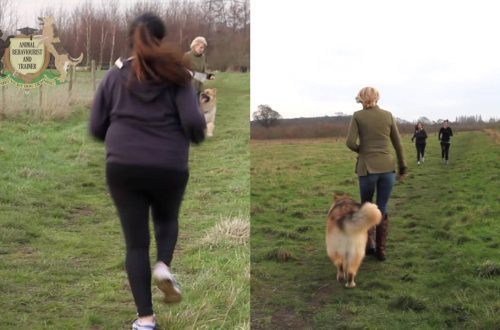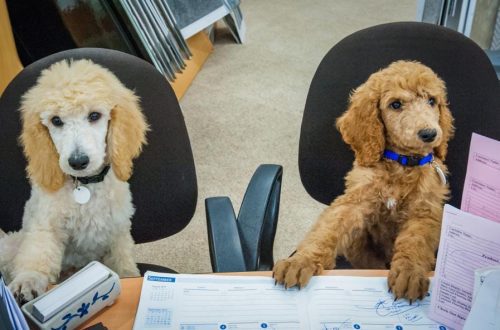
Basic Fitness for Show Dogs: Exercises
These exercises can be mastered by any owner and any dog will perform, regardless of age and structural features.

Contents
Exercise for show dogs on stable surfaces
Single-level exercises: statics with handling elements:
Exhibition stand in one plane for a time (from 30 seconds to 2 minutes). Focus on a stopwatch or set a timer and control the dog in the stance. For a dog, this is very tiring, so if the pet can stand for 2 minutes, you have made huge strides. The pet can be fed at this time.
Multilevel exercises: active muscle contraction
- Squats (from 30 seconds to 1 minute). In terms of quantity, be guided by the capabilities of the dog. The height of the second level is the height of the hock or carpal joint (the front legs are elevated). If the height is greater, the dog will experience discomfort, and the training will no longer be on active muscle contraction, but on stretching. The pace of squats should be as slow as possible.
- Push-ups (from 30 seconds to 1 minute). This time the hind legs are on the rise. The step height is the same as for the previous exercise. You can guide your dog with a treat so that he does push-ups correctly. The elbow of the dog during push-ups should be directed along the body.
Multilevel exercises: coordination load
Climbing to the surface (from 15 seconds to 1 minute). Steps are used (approximately 6), but not a slide. Speed is not important, but a fairly slow pace must be maintained both on the ascent and on the descent. The height of the step is approximately equal to the height of the hock.
Exercise for show dogs on unstable surfaces
One-level exercises: statics with handling elements
Exhibition stand for time (from 10 to 30 seconds). In this case, the dog has to strain very hard to keep himself in the stance. You must be sure that her metatarsus and wrists are perpendicular to the horizon line. Do not allow the opportunity to step under the body or step forward with the forelimbs.
Coordination load
Turns around its axis (minimum 3 in each direction, maximum 7 in each direction). It is desirable that the turns alternate (one in one direction, the second in the other, etc.) Start with a minimum number.
Multilevel exercises: active study of deep muscles
Stretching up / forward with a contraction of the back muscles (minimum 5 – 7 contractions, maximum 10 contractions). It will be difficult for a beginner to notice the contraction of the back muscles, but ideally we should see how the muscles gather in an “accordion” from the withers to the base of the tail. The height of the surfaces is the same as in the previous exercises. The treat that the dog reaches for should be long and soft (not dry food and not something that is very hard to bite off), so that it “gnaws” it correctly, working with the jaw muscles – this is when impulse contractions pass along the back. When the dog reaches up, there should be a straight line from the nose to the base of the tail, the back of the head should drop. The exercise is ideal for working out almost all muscle groups.
Multiaxial: strengthening small muscles
Tilts to the fingers of the limbs (minimum 2 tilts to each paw, maximum 5 tilts to each paw: to one front, second front, opposite hind and remaining hind paw). Exercises are done at a slow pace, which is much harder for the dog. The dog well stretches and strengthens the ligaments of the shoulder, elbow and, in principle, the ligaments of the forelimbs, while completely holding itself on the muscles of the hind limbs. When the dog’s muzzle reaches for the hind legs, the lateral and back muscles are involved, while it is permissible if the dog steps over the front paws (it is not necessary to fix them at one point). You can’t cross with your back legs.
Strengthening the articular-ligamentous apparatus
Lie down / stand (from 5 to 10 times). It is very difficult for a dog to move from one position to another when “the ground leaves from under his feet.” All the muscles of the pectoral limbs, hind limbs are involved, and if you hold the treat correctly (high enough), then load the neck so that the dog holds its head correctly.
Mixed show dog exercises
One-level exercises: statics with handling elements
Stand for time (from 10 seconds to 30 seconds). You can change surfaces: for example, first the dog on an unstable surface with its front paws, and then with its hind legs.
Multilevel exercises: active study of deep muscles
Stretching up / forward with a contraction of the back muscles (minimum 5 – 7 contractions, maximum 10 contractions). When pulling up, you need to hold the dog with a treat so that he does not sit down. The muscles of the lower back, back, neck, pectoral muscles and muscles of the hind limbs are tensed. Achieve muscle contractions from the withers to the base of the tail. When pulling forward, ideally there should be a horizontal line parallel to the floor from the base of the tail to the nose. In this case, the limbs should be perpendicular to the horizon line.
Exercises to strengthen the articular-ligamentous apparatus of show dogs
Sit / stand (from 5 to 10 times). As in the previous exercises, everything is done at the slowest pace possible.

Switching loads in basic fitness for show dogs
- Steeplechase trot (using Cavaletti).
- Walking back. You may be surprised, but most dogs cannot walk backwards. The dog must walk straight, not leaning to one side or the other. The dog must take at least 10 steps with each paw. First, you can create a small narrow corridor (for example, on one side – a wall, on the other – some kind of obstacle).
- Jump up. This is done as slowly as possible, but so that the dog jumped onto some surface, you turn it around its axis, and it carefully jumps off (if the dog is small, it is better to lower it on your hands).

See also:  Basic Fitness Basics for Show Dogs
Basic Fitness Basics for Show Dogs
How to Do Basic Fitness for Show Dogs





